|
This
picture gallery summarizes the invertebrates found under boulders at Playa
Estacion, Puerto Penasco, Sonora, Mexico.
It
should be used to complete lab activity 9.4.
|
Geodia
mesotriaena
|
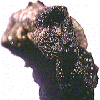 |
"Fuzzy
gray sponge"
| Phylum |
Porifera |
| Class |
Demospongiae |
| Order |
Choristida |
| Family |
Geodiidae |
|
| Morphology |
Its
color varies from white, gray, brown to purple on the outside
and white or pale cream inside. The sponge spreads laterally
into a massive cake, often forming very large colonies. Topped
by leathery with many excurrent openings (oscula).
A distinctive
feature of this sponge is that the large pores(oscula) are restricted
to sieve plates, which are leathery discs about 2-3 sm in diameter,
with many openings. Its internal chambers shelter many other
creatures including small porcelain crabs, brittle stars, and
segmented worms. |
| Feeding |
Filter feeding |
| Defense |
Unpalatable |
| Reproduction |
Asexual budding
and sexual spawning |
| Habitat |
Lives in the
lowest tidal area under boulders. |
| Distribution |
From southern
Alaska to the Gulf of California. |
| Other |
Predators are
few including some nudibranchs and brittle stars. Its internal
chambers shelter many other creatures including small porcelain
crabs, brittle stars, and segmented worms. |
|
|
Prosthiostomum
multicelis
|
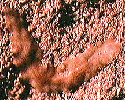 |
"Tan
flatworm"
| Phylum |
Platyhelminthes |
| Class |
Turbellaria |
| Order |
Polycladida |
| Family |
Prosthiostomidae |
|
| Morphology |
Body
pale with a tan overcast and slightly yellow margins. Long,
slender (to 30 mm) tapering to a bluntly pointed posterior. |
| Feeding |
Carnivorous
on small invertebrates |
| Defense |
Ability to cling
to the undersides of stones in very cramped quarters |
| Reproduction |
Cross copulating
hermaphrodites |
| Habitat |
Undersides of
rocks or within crevices or holes of reefs |
| Distribution |
Southern California
to the Gulf of California |
| Other |
|
|
|
Thelepus
nearsetosus
|
 |
"Spagetti
worm"
| Phylum |
Annelida |
| Class |
Polychaeta |
| Order |
Sedentaria |
| Family |
Terrebellidae |
|
| Morphology |
Large
body (to 150 mm long) divided into anterior thorax and posterior
abdomen. There are three pairs of bushy gills and numerous thin
tentacles near the head. |
| Feeding |
Use outstreched
tentacles to feed on detrital particles on the surface. |
| Defense |
Can retract
into a tube constructed of sand grains, bits of shell and mucus
cement. |
| Reproduction |
Separte sexes
and spawning |
| Habitat |
Among rocks
and sand in the low intertidal and shallow subtidal. |
| Distribution |
Northern Gulf
of California |
| Other |
|
|
|
Petrolisthes
gracilis
|
 |
"Slender
rock slider"
| Phylum |
Arthropoda |
| Class |
Crustacea |
| Order |
Decapoda |
| Family |
Porcellanidae |
|
| Morphology |
Small,
very flat, bluish-green crab with white spots. Small, fifth
pair of legs folded over the back edge of the body. The legs
and body are relatively hairless. |
| Feeding |
Filter particles
from water using the hair on their mouth parts |
| Defense |
Hard exoskeleton
and ability to cling to the undersides of stones in very cramped
quarters |
| Reproduction |
Separate sexes.
Females brood eggs under their abdominal flaps until they hatch. |
| Habitat |
Found under
stones. |
| Distribution |
From the upper
Gulf of California and Bahia Magdalena to as far south as Bahia
Tongola-Tangola, Mexico. |
| Other |
|
|
|
Petrolitshes
hirtipes
|
 |
"Fringed
rock slider"
| Phylum |
Arthropoda |
| Class |
Crustacea |
| Order |
Decapoda |
| Family |
Porcellanidae |
|
| Morphology |
Small,
very flat, brown crab with small, fifth pair of legs folded
over the back edge of the body. The legs all bear a long fringe
of hair. |
| Feeding |
Filter particles
from water using the hair on their legs and mouth parts |
| Defense |
Hard exoskeleton
and ability to cling to the undersides of stones in very cramped
quarters |
| Reproduction |
Separate sexes.
Females brood eggs under their abdominal flaps until they hatch. |
| Habitat |
Common under
stones and in crevices of reefs, coral and sponges in the lower
intertidal. |
| Distribution |
Lower Pacific
Baja and throughout the Gulf of California. |
| Other |
|
|
|
Clibanarius
digueti
|
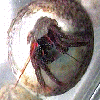 |
"Red-fingered
hermit crab"
| Phylum |
Arthropoda |
| Class |
Crustacea |
| Order |
Decapoda |
| Family |
Diogenidae |
|
| Morphology |
Red
in appearance, has an unexplained olive color phase. Light speckling
(blue) over the chelipeds and walking legs, antennaes are bright
red to orange, carapace is tan to gray. |
| Feeding |
Filter feeders
and scavengers |
| Defense |
Occupies the
shell of a dead snail |
| Reproduction |
Separate sexes.
Females brood eggs on pleopods until they hatch.
April - September, the male gives a chase over a 12 hour period
where the female is rotated, jiggled, tickled, and finally,
seduced. |
| Habitat |
In the mid and
upper intertidal zones, sandy short habitats with rock outcrops
or shell debris, mangrove swamps, under boulders and rock surfaces. |
| Distribution |
Lower Pacific
Baja and throughout the Gulf of California |
| Other |
Most common
hermit crab of the Gulf of California.
Gregarious
at low tide forming clusters of up to 700 individuals. Disperse
when the tide is changing. |
|
|
Paguristes
anahuacus
|
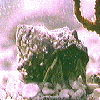 |
"Blue-eyed
hermit crab"
| Phylum |
Arthropoda |
| Class |
Crustacea |
| Order |
Decapoda |
| Family |
Diogenidae |
|
| Morphology |
Cream
colored hermit crab with hairy, equal sized claws, and blue
tipped antennae. Young have blue eyes. |
| Feeding |
Filter feeders
and scavengers |
| Defense |
Occupies the
shell of a dead snail |
| Reproduction |
Separate sexes.
Females brood eggs on pleopods until they hatch. |
| Habitat |
Under boulders
and on the surfaces of rocky shores in the lower intertidal,
in tidepools and in the shallow subtidal |
| Distribution |
Gulf of California |
| Other |
Second most
abundant rocky shore hermit crab in the Gulf of California.
Gregarious. |
|
|
Pilumnus
townsendi
|
 |
"Townsend's
hairy crab"
| Phylum |
Arthropoda |
| Class |
Crustacea |
| Order |
Decapoda |
| Family |
Xanthidae |
|
| Morphology |
Identified
by four spines on the front outside edges of the body and spiny,
hairy claws. Two different types of hairs on the purple body:
one is long and stiff and the other is short and soft. |
| Feeding |
Scavengers who
feed on floating food particles. |
| Defense |
Claws and hard
exoskeleton and able to hide in small cavities |
| Reproduction |
Separate sexes.
Females brood eggs on pleopods until they hatch. |
| Habitat |
Live under rocks
and boulders; some prefer drainage channels in rocky areas where
they have access to constant water. |
| Distribution |
Upper gulf to
Bahia Manzanillo. |
| Other |
One of many
hairy crabs living in the Gulf of California intertidal. Docile
to handle, rarely large enough to pinch. |
|
|
Tetragrapsis
jouyi
|
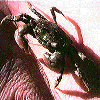 |
"Square
shore crab"
| Phylum |
Arthropoda |
| Class |
Crustacea |
| Order |
Decapoda |
| Family |
Grapsidae |
|
| Morphology |
Small,
dark, square bodied crab with equal sized claws and slender
hairy legs. |
| Feeding |
Scavengers |
| Defense |
Claws and hard
exoskeleton. Fast moving, cryptically colored and able to hide
in small cavities |
| Reproduction |
Separate sexes.
Females brood eggs on pleopods until they hatch. |
| Habitat |
Under rocks
in sandy areas, sand and mud flats of the upper intertidal. |
| Distribution |
Gulf of California |
| Other |
|
|
|
Alpheus
californiensis
|
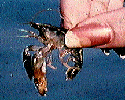 |
"Snapping
shrimp"
| Phylum |
Arthropoda |
| Class |
Crustacea |
| Order |
Decapoda |
| Family |
Alpheidae |
|
| Morphology |
Colorful,
fast, backwards swimming shrimp that are easily identified by
their one large claw that is modified for making loud clicking
or popping noises. |
| Feeding |
Snap large claw
to stun prey. Use claw to grab small animals or morsels of food
floating by. |
| Defense |
Hard shell on
body (after molting, the body is soft. The shell hardens after
a few hours, however, during that time they are vulnerable). |
| Reproduction |
Separate sexes.
Females brood eggs on pleopods until they hatch. |
| Habitat |
Lives in tunnels
under rocks in a sandy substrate. |
| Distribution |
Southern California
to the Gulf of California, common at Puerto Penasco |
| Other |
If large claw
is pulled off the other hand will develop a large claw. |
|
|
Selenkothuria
lubrica
|
 |
"Sulfur
cucumber"
| Phylum |
Echinodermata |
| Class |
Holothuroidea |
| Order |
Aspidochirota |
| Family |
Holothruiidae |
|
| Morphology |
Maximum
length of 15 cm, usually a sulfur-yellow color (tips of their
feet), the base color ranges from gray-brown to purplish-black. |
| Feeding |
Plankton eaters. |
| Defense |
Will eject part
of its stomach lining as a decoy when disturbed. |
| Reproduction |
Separate sexes
and spawning |
| Habitat |
Under rocks
in the lower mid intertidal zone in a cluster. |
| Distribution |
Ranges from
upper Gulf of California to Ecuador and the Galapagos Islands. |
| Other |
|
|
|
Echinometra
vanbrunti
|
 |
"Purple
sea urchin"
| Phylum |
Echinodermata |
| Class |
Echinoidea |
| Order |
Camarodonta |
| Family |
Echinometridae |
|
| Morphology |
A
dark purple urchin with long (one inch) slender spines. |
| Feeding |
Graze on algae |
| Defense |
The brittle
spines may break off and cause puncture wounds that are very
painful. |
| Reproduction |
Separate sexes
and synchronous spawning |
| Habitat |
Intertidally
on rocky substrate.Particularly in crevices and cavities in
rocks and reefs, where it can avoid the full impact of the surf. |
| Distribution |
Northern Gulf
of California to Peru and Galapagos Islands. |
| Other |
|
|
|
Ophiocoma
aethiops
|
 |
"Black
spiny brittlestar"
| Phylum |
Echinodermata |
| Class |
Ophiuroidea |
| Order |
Ophiurae |
| Family |
Ophiocomidae |
|
| Morphology |
Largest
and most striking brittle star, the arm spines are long and
perpendicular to the arm axis. The aboral surface is purple-black.
Diameter is 3.5 to 19.5 inches. |
| Feeding |
Opportunistic
feeder that does eat carrion. |
| Defense |
Have break-away
arms that they can regenerate. Seek darkness remaining under
rocks during the day. |
| Reproduction |
Separate sexes
and spawning. |
| Habitat |
Common on rocky
shores, under rocks or in crevices of the lower mid intertidal
zone. |
| Distribution |
East Pacific
region, upper Gulf to Panama and the Galapagos Islands. |
| Other |
|
|
|
Ophiocoma
alexandri
|
 |
"Alexander's
spiny brittlestar"
| Phylum |
Echinodermata |
| Class |
Ophiuroidea |
| Order |
Ophiurae |
| Family |
Ophiocamidae |
|
| Morphology |
Large
brittle star. Arm spines are perpendicular to the arm axis,
arms are banded with gray and white. The disk is light brown
or pale green, usually with a white blotch at the base of the
arm spine. Diameter is 3.5 to 17.5 inches. |
| Feeding |
Opportunistic
feeder |
| Defense |
Have break-away
arms that they can regenerate. Seek darkness remaining under
rocks during the day. |
| Reproduction |
Separate sexes
and spawning. |
| Habitat |
Common in the
rocky low to mid intertidal. |
| Distribution |
From the upper
Gulf to Panama and the Galapagos Islands even to the Caribbean
region. |
| Other |
|
|
|
Ophionereis
annulata
|
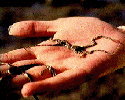 |
"Ringed
brittlestar"
| Phylum |
Echinodermata |
| Class |
Ophiuroidea |
| Order |
Ophiurae |
| Family |
Ophiochitonidae |
|
| Morphology |
Small
to medium-sized species of brittle star, arm spines perpendicular
to the arm axis. Black and white in color. Diameter is 3 to
12.5 inches. |
| Feeding |
Filters particles
from the water using its arms |
| Defense |
Have break-away
arms that they can regenerate. Seek darkness remaining under
rocks during the day. |
| Reproduction |
Separate sexes
and spawning. |
| Habitat |
Found in the
midtidal zone and occasionally in the low intertidal. |
| Distribution |
Ranges from
southern California and the upper Gulf to Ecuador and the Galapagos
Islands. |
| Other |
|
|
|
Heliaster
kubinijii
|
|
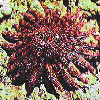
|
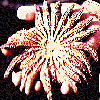 |
"Gulf
sun star"
| Phylum |
Echinodermata |
| Class |
Asteroidea |
| Order |
Forcipulata |
| Family |
Heliasteridae |
|
|
| Morphology |
A
pinkish-lavender seastar with black and green mottling, and
19 to 25 rays (starts life with 5 but adds rays as it matures).
Diameter is 2.5 to 8 inches. |
| Feeding |
An indiscriminate
top carnivore that prefers barnacles and small bivalves but
will eat snails, chitons, small crabs and other invertebrates. |
| Defense |
Tough, spiny
skin. |
| Reproduction |
Separate sexes
and spawning. Spawn in early spring. |
| Habitat |
On and under
rocks in the intertidal |
| Distribution |
Baja California,
throughout the Gulf of California, south to Nicaragua |
| Other |
The most common
starfish in the Gulf of California until 1978 when a massive
die off occurred. The Gulf sun star has since made a come back
but is still relatively rare. |
|
|
Aplidium
sp.
|
 |
"Sea
pork"
| Phylum |
Chordata |
| Class |
Ascidiacea |
| Order |
Enterogona |
| Family |
Polyclinidae |
|
| Morphology |
Large,
fleshy colonies made up of subunits. Each subunit contains many
individuals arranged radially around an excurrent pore and covered
by a gelatinous tunic. The colony is smooth and firm to the
touch and from pale to vivid orange in color. |
| Feeding |
Filter feeder.
Each individual produces a ventilating current using a ciliated,
sticky basket-like paharynx to strain particles from the water. |
| Defense |
Produces distasteful,
poisonous chemicals |
| Reproduction |
Sexually produced
tadpole larvae have all the characteristics of chordates and
are somewhat fish-like. These settle and transform into sessile
adults which bud to produce a colony. |
| Habitat |
Under rocks
in the intertidal and on rock surfaces in the subtidal. |
| Distribution |
|
| Other |
|
|
|

















